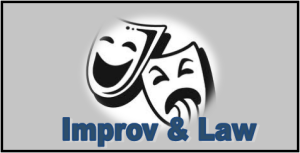Tina Fey Has 4 Rules to Improve Your Practice
 Improv actors and attorneys have a lot in common.
Improv actors and attorneys have a lot in common.
Both have to be quick on their feet and good under pressure. Both need a sense of humor. And most important, both have to be able to work – and play – well with others.
Improvisational techniques are used in the classroom for educational purposes and in major corporations to promote teamwork. Professors at MIT’s Sloan School of Management and Duke’s Fuqua School of Business teach it in MBA courses. It’s even used in psychotherapy as a way to break though a patient’s mental and emotional blocks.
In her best-selling book Bossypants, actress Tina Fey offers four improv principles that can be used in your practice:
Rule 1: Start With “Yes”
This shows agreement and respect. It opens the door to innovation, progress and solutions. Saying “no” brings the curtain down.
“When you’re first interacting with a potential or new customer, they may start by sharing with you a description of their situation and the challenges they face,” says one business CEO. “Your immediate temptation may be to solve them immediately or at least suggest alternatives for them to try. Accepting their reality means avoiding this temptation and instead agreeing and letting them share the issues they’re most impacted by. You will get your chance later.”
Saying yes doesn’t mean you necessarily agree with what was said. It simply acknowledges that you get what the other person is trying to communicate. Later you can say “no,” or “maybe,” or “not now.” But starting with “yes” begins the relationship on a positive note.
Rule 2: Add “Yes, And”
This takes the conversation to a deeper level. It drills down to reveal hidden needs and motivations. It provides continuity to keep things on course.
“The second rule of improvisation is not only to say yes, but YES, AND,” Fey writes. “You are supposed to agree and then add something of your own. If I start a scene with ‘I can’t believe it’s so hot in here,’ and you just say ‘Yeah’ we’re kind of at a standstill. But if I say, ‘I can’t believe it’s so hot in here,’ and you say, ‘What did you expect? We’re in hell!’ now we’re getting somewhere.”
Rule 3: Make Statements
A series of questions is an interrogation. A series of back-and-forth statements is a discussion.
“Don’t ask questions all the time,” Fey writes. “If we’re in a scene and I say, “Who are you? Where are we? What are we doing here? What’s in that box?” I’m putting pressure on you to come up with all the answers. In other words: Whatever the problem, be part of the solution. Don’t just sit around raising questions and pointing out obstacles. We’ve all worked with that person. That person is a drag.”
Rule 4: There are No Mistakes, Only Opportunities
Sometimes what looks like a flub is actually good fortune in disguise. Example: an accident at a glue factory led to the invention of Post-It notes.
“Just like improv, not every project will go as planned,” says one business coach. “You can take the amateur approach; stop the scene, destroy the momentum, and start over. Or you can be a pro; adapt to the change, make it your own, and do something greater.”
There’s no script to practicing law. You never know what lies ahead. By using improvisational skills, you can be ready for whatever happens next.
Sources:
- CNN http://www.cnn.com/2010/BUSINESS/02/18/improvisation.business.skills/index.html
- Tina Fey, Bossypants https://www.amazon.com/dp/B0047Y0FGY/ref=dp-kindle-redirect?_encoding=UTF8&btkr=1
- American Express Open Forum https://www.americanexpress.com/us/small-business/openforum/articles/how-tina-feys-improv-rules-can-boost-your-business/
- My Careertopia http://www.mycareertopia.com/tina-feys-rules-for-improv-and-the-workplace/
- DSI Comedy Theater http://www.dsicomedytheater.com/
- Thinktopia http://thinktopia.com/2011/04/29/tina-fey%E2%80%99s-4-rules-of-innovation/




